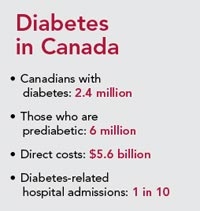An Overview from the Cardiovascular Perspective
Diabetes is a large and growing problem in Canada, with diabetic patients at much greater risk for dangerous cardiovascular events, including recurrent heart attacks and the development of heart failure. Because it’s such a major contributor to heart disease, diabetes is often first diagnosed in the process of treating a heart condition. In recognition of this close relationship, CCC gathered an expert panel to present “The ABCs of Diabetes” for cardiovascular professionals.
In individuals with diabetes, high glucose is the obvious concern, but cholesterol is also important. High blood glucose levels contribute to the oxidative damage of the walls of blood vessels. High cholesterol contributes to this process and hastens the onset of coronary artery disease. The impact of diabetes on cardiovascular health is more far reaching, though. Individuals with high blood sugar have worse outcomes following a heart attack, and they are more likely to suffer microvascular damage.

Active blood sugar management is essential. Patients feel better, their quality of life is improved and microvascular events are reduced. In addition to lifestyle changes, such as diet, weight management and exercise, several types of drugs are available to treat diabetes. However, the impact on heart disease of medically managing glucose is disappointing, and most available drugs have significant downsides. Both insulin and glinides, for example, increase the risk of low blood sugar—even minor hypoglycemia negatively impacts patient well-being—and insulin use can often also result in weight gain.
The panel recommended that lifestyle changes and metformin should be the first line of response. A new class of drugs, called incretins, looks to offer a more wholly positive alternative in the future. Incretins have fewer downsides and tend to decrease body weight. Several large trials are under way to assess these drugs for long-term outcomes.
Integrated Diabetes Management Program Provides Rapid Improvements in Patient Care
Elsewhere at the congress, Heart Institute nurses gave a series of presentations about the Institute’s integrated Diabetes Management Program. “Patients with diabetes account for a disproportionately high number of hospital inpatients, globally. At the Heart Institute, more than 40 per cent of all our inpatients are diagnosed with diabetes,” reported Bonnie Quinlan, advanced practice nurse for cardiology.
Heart Institute staff recognized that hospitalization for heart disease provides a valuable opportunity to identify patients with uncontrolled or undiagnosed diabetes and connect them with the care they need—similar to how the Ottawa Model for Smoking Cessation uses hospitalization as a unique opportunity to help smokers quit.
In May 2011, the Heart Institute rolled out a pilot program to identify and manage every patient with diabetes admitted as an inpatient. The program trained 15 nurses to serve as “diabetes champions” on the wards, led by newly hired diabetes nurse specialist Kim Twyman.
These champions provided peer-to-peer training to other nurses, doctors, dietitians and residents, centred around a new guideline and educational “tool box” designed to walk staff through the steps for identifying and managing diabetes with every patient. In February 2012, this optional guideline became a mandatory directive, and by March, the number of patients referred to the diabetes nurse specialist had doubled.
The effort paid off in several ways. After implementation, 85 per cent of patients’ doctors were notified of their diabetic status compared with 26 per cent before the program. Thirty-four per cent received a referral to a community diabetes management program compared with none before the program.
Most important, average blood sugar levels in diabetic inpatients dropped by almost two points to the target level for adequately managed diabetes. “This was amazing,” recounted Amy Charlebois, one of the nurse champions.
“Staff felt empowered by being able to manage their patients’ diabetes,” said Quinlan. “And they received tremendous positive feedback from patients and families who in many cases were for the first time, receiving support to assist them in managing this chronic disease.”
Ongoing challenges include fitting all the pieces of the program into brief patient stays, such as overnight or elective day surgery, and influencing patients who are unable to face an unexpected diagnosis.

